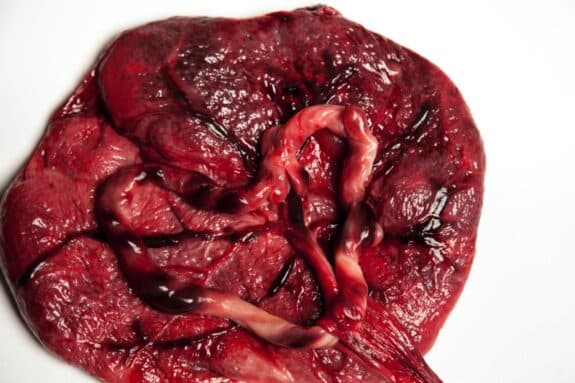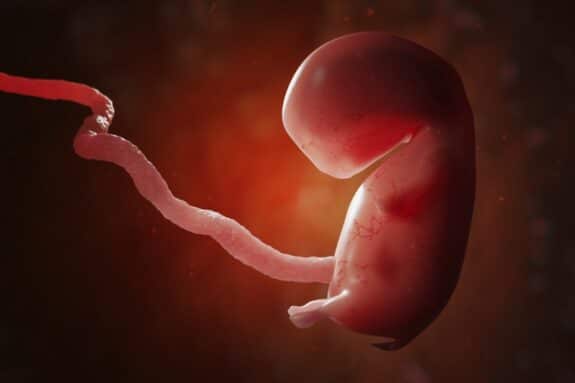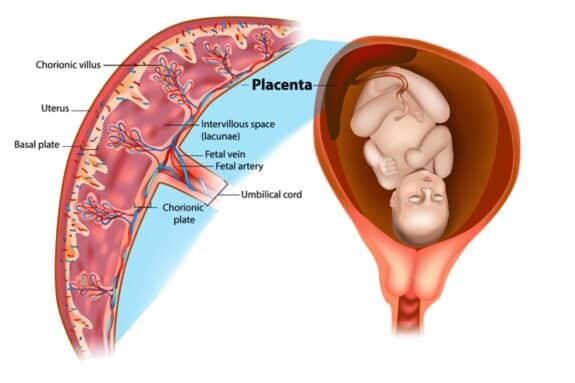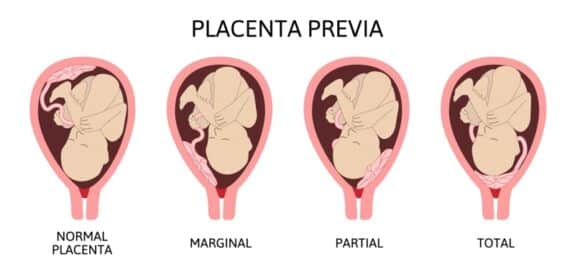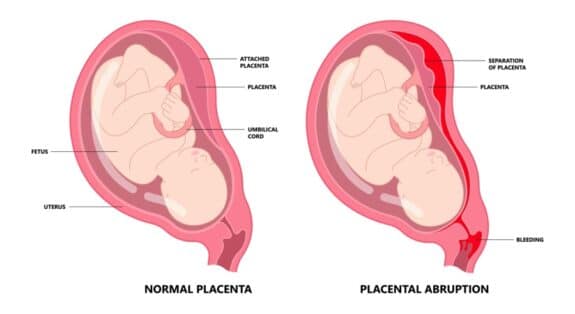What does your placenta do and how does it benefit your baby?
This is a common question for new moms.
When a woman is pregnant, one of the most important organs responsible for sustaining the pregnancy is the placenta. It plays an essential role in providing nutrition and oxygen to the baby while in utero. In this blog, we will discuss what you need to know about placenta function and complications that can arise during pregnancy. In fact, when your baby is born your placenta will weigh about 500 grams or just over a pound!
The placenta is a temporary organ that develops during pregnancy and attaches to the wall of the uterus. It acts as a link between mother and baby, allowing nutrients, antibodies, and oxygen from the mother’s blood supply to be transferred across the placental barrier into her baby’s bloodstream. The placenta also removes waste products such as carbon dioxide from your baby’s bloodstream. This type of exchange is known as placental transfusion. This helps ensure that your baby has everything it needs to grow healthy and strong during its time in utero.
Development
When the zygote becomes a blastocyst some cells begin to form into the placenta and others begin to form in the fetus. The growing fetus is fed by womb milk, a lining of the uterus that feeds the baby glycogen. By week 11 this formula has dried up and the newly formed placenta takes over the nourishment of your baby.
This timing is not a mistake. At the beginning of a pregnancy, the pressure of arterial blood from the placenta would be too strong. The fetus is big enough at 11 weeks to withstand and accept its mother’s blood.
The placenta attaches itself to the uterine wall. The umbilical cord has three blood vessels: one vein that carries food and oxygen from the placenta to your baby and two arteries that carry waste from your baby back to the placenta. The two work together to nourish and grow your baby.
Placental blood flow is an important process for a healthy pregnancy and delivery. The volume of placental blood flow is about 600–700 ml/minute (80% of the uterine perfusion) at term.
Placental Conditions
Though rare, there are some complications that can arise with placenta function if not properly monitored by your doctor or midwife throughout your pregnancy. These include conditions like:
- Placenta Previa
- Placental Abruption
- Placental Insufficiency
- Preeclampsia
It is important to be aware of these potential issues so they can be monitored closely by your healthcare provider throughout your pregnancy.
Placenta Previa
Placenta previa is a potentially dangerous pregnancy complication that can affect the health of both mother and baby. It occurs when the placenta implants in an abnormal position in the uterus such as over or near the opening to the cervix. This condition is more likely to occur when an expectant mother has had multiple pregnancies, undergone previous cesarean sections, or has any type of scarring on her uterus.
Placental previa can cause symptoms such as vaginal bleeding, painless contractions, premature labor and delivery, and even fetal distress; the main goal of treatment is to ensure a safe delivery by preventing preterm labor. It can be diagnosed through ultrasound imaging during regular prenatal visits with a healthcare provider. With appropriate medical care and intervention, moms-to-be can experience safe childbirth outcomes.
Placental Abruption
Placental abruption is a serious pregnancy complication that involves premature detachment of the placenta from the uterine wall. It can occur at any time during the pregnancy term, though it occurs most often during the third trimester. This condition can cause severe bleeding and disrupt normal oxygen and nutrient delivery to the unborn baby. Placental abruption requires urgent medical attention as it may lead to significant complications such as fetal distress, premature birth, or stillbirth. Expectant women who experience signs such as vaginal bleeding, abdominal pain, and decreased fetal movements should seek medical assistance immediately. Fortunately, prompt treatment may help save a pregnancy.
Placental insufficiency
Placental insufficiency is a condition that occurs during pregnancy when the placenta does not grow and develop sufficiently to provide for the needs of the baby. Placental insufficiency can lead to pregnancy complications, including low birth weight, preterm delivery, stillbirth, or even neonatal death. Placental insufficiency requires close monitoring throughout the rest of the pregnancy and medical interventions may be needed in order to avoid any long term adverse effects to both mother and child. If caught early and managed appropriately, there’s a high chance for good outcomes for both mother and baby.
Preeclampsia
Preeclampsia is a dangerous pregnancy complication that can have life-threatening effects on both the mother and baby. It occurs due to damaged blood vessels in the placenta which interferes with nutrient and oxygen flow, leading to increased blood pressure, organ damage, and fluid retention in various parts of the body. Due to its complexity, the exact causes are still not well understood. While early diagnosis and prompt medical treatment are absolutely essential for a successful outcome, many women still suffer from symptoms including headache, edema, vision problems, nausea, and vomiting. Unfortunately, there is no known cure for preeclampsia- only close monitoring during pregnancy can help manage any potential problems as they arise. With proper care and regular checkups throughout the duration of pregnancy at risk for preeclampsia, mothers can give their babies the best chance at a safe delivery day.
After Your Baby Arrives
Delivering your placenta is an important step in the birthing process. The placenta connects your unborn baby to you and provides nutrients and oxygen while in the womb. When the baby is born, it is still connected to the placenta until it can be safely delivered. Placental delivery is typically done once the umbilical cord has been cut, either manually or with medical assistance. Placental delivery can sometimes take up to 30 minutes, so it is important for new mothers and their babies to be closely monitored throughout the process for any signs of distress or abnormality. Afterward, the doctor will check that no pieces of placenta remain inside the woman’s body before she can go on to heal from childbirth.
Benefits Of Late Clamping
Late umbilical cord clamping is a practice where the umbilical cord is left to stop pulsating, or until it stops pumping blood, before cutting it after a baby is born. This practice has been gaining greater attention in recent years due to its purported health benefits for newborns. It has been hypothesized that the extra 10-90 seconds between birth and umbilical cord clamping may yield long-term advantages in terms of iron levels and genetic material transfer from mother to baby. Studies have indicated that late umbilical cord clamping facilitates better adaptation of the newborn’s physiology, as well as potentially improving iron nutrition during infancy as compared to early umbilical cord clamping procedures.
The placenta is an essential organ during pregnancy that provides vital nutrients and oxygen for the growth and development of a fetus while in utero. Though rare, there are some potential complications that can arise with placenta function such as placental abruption or preeclampsia which should be monitored closely by your healthcare provider throughout your pregnancy. Knowing what you need to know about placenta function can help ensure a safe delivery for both you and your baby!
SOURCES:
- https://www.healthline.com/health/pregnancy/when-does-the-placenta-form#when-it-takes-over
- https://www.newscientist.com/article/dn27460-womb-milk-nourishes-human-embryo-during-first-weeks-of-pregnancy/#ixzz6m7suwYle

